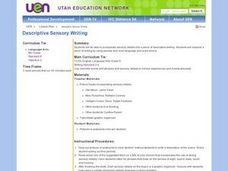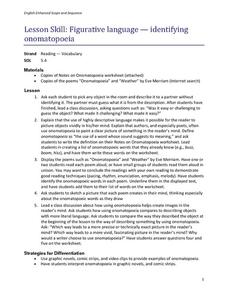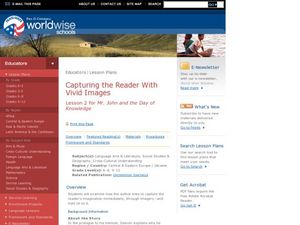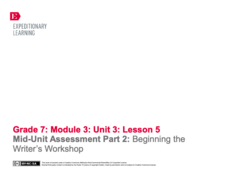Curated OER
The Adventures of Tom Sawyer: Using Vivid Language
Analyze the components of precise wording and vivid language in this language arts lesson plan. Middle school writers illustrate a passage from Mark Twain's The Adventures of Tom Sawyer, and write a response to a Norman Rockwell print....
EngageNY
Continued Close Reading of Bullfrog at Magnolia Circle: Text-Dependent Questions and Vivid Words and Phrases
As 3rd graders continue reading Bullfrog at Magnolia Circle, they focus on the concepts of predator and prey in the fifth lesson plan of this unit. Scholars further develop their ability to answer questions using evidence from the text...
EngageNY
Continued Close Reading of Bullfrog at Magnolia Circle: Text-Dependent Questions and Vivid Words and Phrases
In the third activity from this unit based on the book Bullfrog at Magnolia Circle, learners focus on using specific details from the text-to-answer questions about the habitat of bullfrogs. While reading the text, young scholars are...
Curated OER
Descriptive Prompt: Precise Language
Incorporate sensory details into a piece of descriptive writing. First, elementary and middle schoolers improve a piece of writing by using precise, vivid language, as well as appropriate word choice. They then listen to a variety of...
Curated OER
Grammar Worksheets: Using Strong Verbs
Strengthen your pupils' writing with this worksheet, which provides a reference guide to using strong verbs instead of forms of is and have. Learners then rewrite twelve sentences to make them stronger. This is a great activity to work...
Curated OER
Vivid Verbs
Spice up your writing! Your amateur writers will benefit from concentrating on understanding and improving verb use in writing. An introductory activity addresses weak verbs. A second exercise helps them see the importance of strong...
EngageNY
Writing to Show, Not Tell: Dialogue, Sensory Words, and Strong Action Verbs
Consume, gobble, devour ... serving up strong verbs! Writers focus on using dialogue, strong action verbs, and sensory details in their writing. After analyzing a model narrative, they apply their learning to their own hero's journey...
Curated OER
Lesson: Patience, Practice and Persistence
First the class analyzes the painting, Rodeo-Pickup Man by Frank Mechau, then they get to work. They explore the painting through verbal descriptions, focusing on vivid language to describe detail. They then compose a written piece using...
Curated OER
Agriculture Awareness Through Poetry
Whether you are viewing a landscape painting of a farm, examining a still-life portrait of a bowl of fruit, or reading a descriptive poem about cultivating food, you can't deny that agriculture plays a major role in visual and language...
Curated OER
Strong Verbs
Add interest to your class's writing by having them focus on strong verbs. Using this learning exercise, first have them identify all of the main verbs in each sentence. Then, have them rewrite each sentence using a stronger verb....
Virginia Department of Education
Developing an essay: Using specific nouns, strong verbs, and vivid adjectives
Feeling bored and unimpressed with word choice in your class? If so, consider this activity, which focuses on using specific and precise language. Pupils use highlighters, brainstorm independently and in small groups, and create a poster...
Curated OER
Figurative Language- Identifying Onomatopoeia
A study of onomatopoeia for 5th graders is here for you. Pupils discover that the use of highly descriptive language makes it possible for readers to picture objects in their minds. After engaging in a class discussion and listening to...
Read Works
The Language of Setting
Descriptive language can be used to create a vivid and imaginative setting. Create the chart suggested in this plan to track the descriptive language found in The Wizard of Oz by L. Frank Baum. The class discusses the land beyond...
EngageNY
Writing the Children’s Book: Day One
With a brief mini-lesson, scholars learn about using strong verbs, sensory details, and precise descriptions. Next, pupils continue working on their children's book storyboards before choosing their strongest pages for peer critiques.
Curated OER
Grab Your Reader: Great Leads
Get your readers' attention with this Six Traits of Writing lesson plan. First, young writers draft ideas in an organized manner utilizing words, sentences, and multiple paragraphs. They also use voice to fit the purpose and audience and...
Roald Dahl
Charlie and the Chocolate Factory
You can't read Roald Dahl's Charlie and the Chocolate Factory without craving the rich treats described in Dahl's vivid prose. Young writers try their hands at sensory language with a lesson plan that prompts them to write about their...
Curated OER
Capturing the Reader with Vivid Images
In this using vivid images worksheet, pupils identify vivid images and analyze their effectiveness in John Deever's "Mr. John and the Day of Knowledge." Students then write rich images for their classmates to imagine.
EngageNY
Mid-Unit Assessment Part 2: Beginning the Writer’s Workshop
Writers learn about using sensory details as they revise bland sentences with more vivid language. Next, they begin writing the first drafts of their children's books, completing storyboards to effectively plan their writing.
Curated OER
Capturing the Reader With Vivid Images
Students examine the use of imagery to hold a reader's attention in an excerpt from John Deever's memoir "Mr. John and the Day of Knowledge". They are introduced to background information about the Ukraine and create original imagery.
National Endowment for the Humanities
Vengeful Verbs in Shakespeare’s “Hamlet”
It's time for pupils to read, examine, and contemplate literature to explore the difference between vivid and generic verbs. Pupils distinguish between the two types of verbs as they read the ghost scene from Shakespeare's Hamlet. They...
Curated OER
Setting Worksheet
Set your class up for success with writing descriptive settings with these two graphic organizers. On the first page, writers note specifc details about their chosen setting and comment on how each character views the setting. The second...
Curated OER
Three Skeleton Key: Elements of Literature
Rats! How are they described in "Three Skeleton Key," and what happens to the characters in the story? Study the vocabulary and the story with these worksheets. Learners complete pre-reading activities, study vocabulary, complete...
Curated OER
Example of a Description of Action
Read the descriptive paragraph (included) with your middle schoolers, and have them study the stylistic elements included. They'll look for vivid verbs, alliteration, assonance, similes, and personification. Before writers craft their...
Curated OER
Fear Factor Fun
Students develop "Fear Factor" stunts using descriptive language. In this writing lesson, students watch clips from the show "Fear Factor" and develop their own stunts. Students write and explain the stunts in vivid language.

























